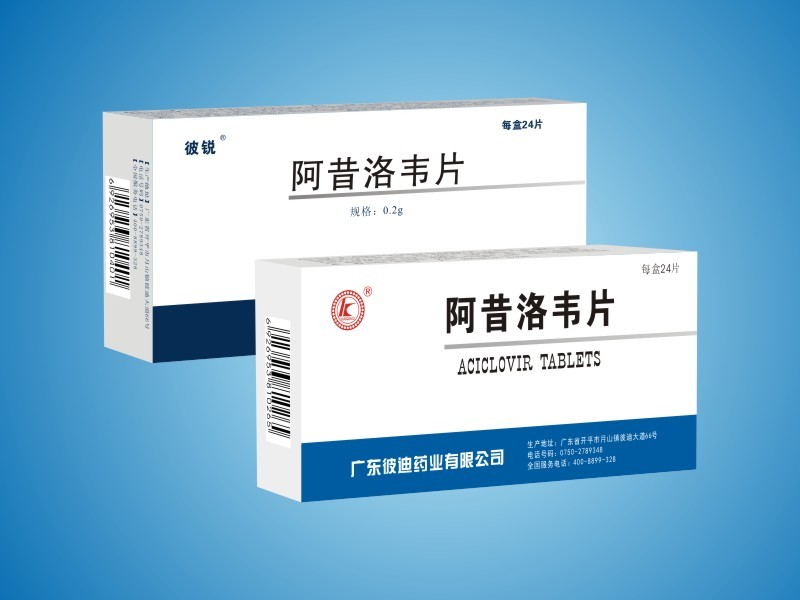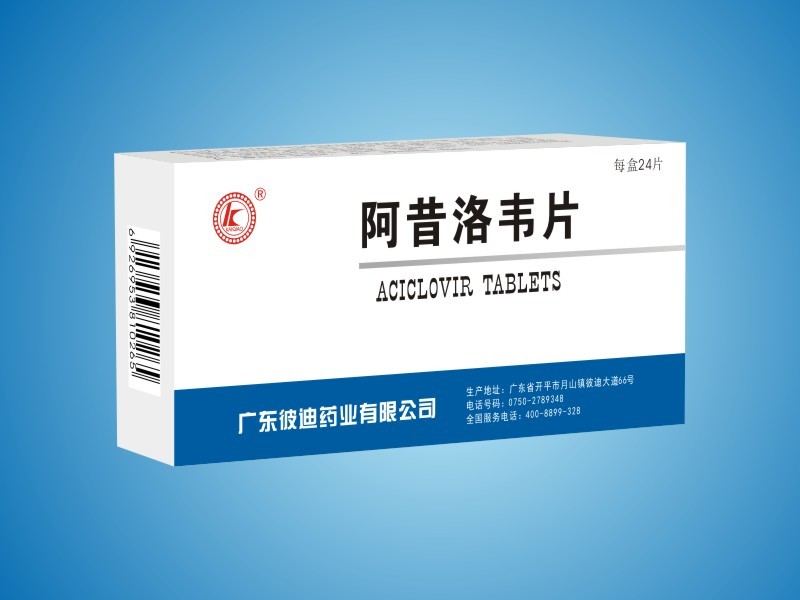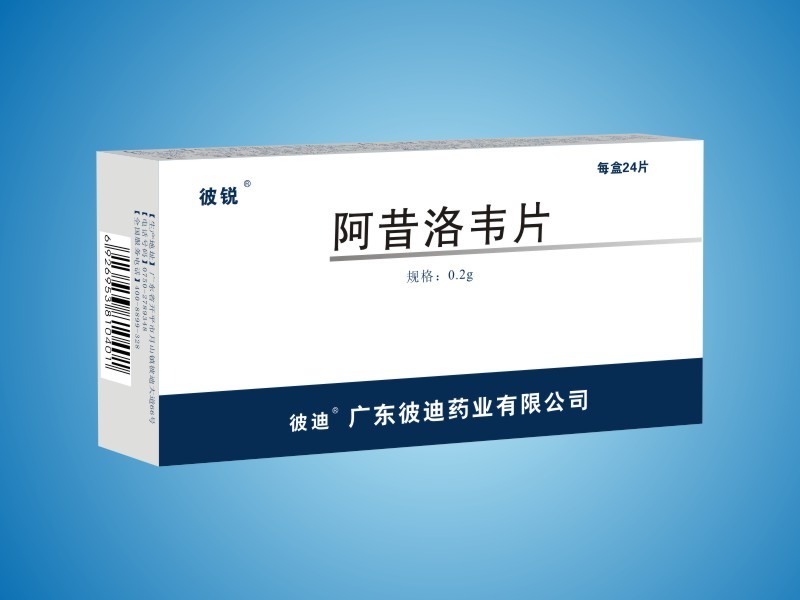
Details
Date of approval: January 29, 2007
Date of revision: April 2, 2009
October 01, 2010
November 30, 2015
Acyclovir tablet instructions
Please read the instructions carefully and use them under the guidance of a physician.
Acyclovir can cause acute renal failure. Patients with renal impairment can cause death when treated with acyclovir. When using acyclovir, careful observation of signs and symptoms of renal failure (such as oliguria, anuria, hematuria, back pain, bloating, nausea, vomiting, etc.), and monitoring changes in urine routine and renal function, once present Abnormalities should be discontinued immediately. The indications and dosages recommended in the instructions should be strictly followed to avoid excessive application. With acyclovir, adequate water should be ingested to prevent drug deposition in the renal tubules. Special attention should be paid to the use of acyclovir in patients receiving potentially nephrotoxic drugs, as this may increase the risk of renal dysfunction and increase reversible central nervous system symptoms. Older people, pregnant women and children should use acyclovir carefully or under surveillance.
【Drug Name】
Generic name: acyclovir tablets
English name: Aciclovir Tablets
Chinese Pinyin: Axiluowei Pian
[Ingredients] The main ingredient of this product is: acyclovir. Its chemical name is: 9-(2-hydroxyethoxymethyl)guanine.
Molecular formula: C8H11N5O3
Molecular weight: 225.21
【Properties】 This product is white or off-white.
[indications]
1. Herpes simplex virus infection: for the initial and recurrent cases of genital herpes virus infection, oral administration of this product for recurrent cases for prevention.
2. Herpes zoster: for the treatment of patients with normal immune function, herpes zoster and mild cases of immunodeficiency.
3. Treatment of chickenpox with immunodeficiency.
[Specification] 0.1g
[Usage and dosage] Oral
1. genital herpes initial treatment and immunodeficiency skin mucosa herpes simplex: adult commonly used amount of 0.2g (2 tablets), 5 times a day, a total of 10 days; or a 0.4g (4 tablets), 3 times a day, a total of 5 days; recurrent infection once 0.2g (2 tablets), 5 times a day for 5 days; chronic inhibition therapy for recurrent infection, once 0.2g (2 tablets), 3 times a day for 6 months, necessary The hourly dose can be added to 5 times a day, once 0.2g (2 tablets) for a total of 6 to 12 months.
2. Herpes zoster: 0.8g (8 tablets) once a day for adults, 5 times a day for 7 to 10 days.
3. Adult patients with renal insufficiency should adjust the dose according to the following table;
Creatinine clearance (ml/min) or (ml/sec)
Dose (g)
Dosing interval (hours)
Genital herpes
Initial or intermittent therapy
>10(0.17)
0.2
4 (5 times a day)
0 to 10 (0 to 0.17)
0.2
12
Chronic inhibition therapy
>10(0.17)
0.4
12
0 to 10 (0 to 0.17)
0.2
12
Herpes zoster
>25 (0.42)
0.8
4 (5 times a day)
10 to 25 (0.17 to 0.42)
0.8
8
0 to 10 (0 to 0.17)
0.8
12
4. Chickenpox: Children over 2 years old are 20mg/kg by weight, 4 times a day for 5 days, and symptoms begin to start treatment immediately. The usual amount of children and adults over 40kg is 0.8g (8 pieces) once, 4 times a day for 5 days.
[adverse reactions] occasional dizziness, headache, joint pain, nausea, vomiting, diarrhea, stomach discomfort, loss of appetite, thirst, decreased white blood cells, mild increase in proteinuria and urea nitrogen, itchy skin, etc., long-term administration See acne, insomnia, menstrual disorders.
[Contraindications] Disabled for allergic to this product.
【Precautions】
1. People who are allergic to ganciclovir may also be allergic to this product.
2. Dehydration or existing liver and kidney dysfunction should be used with caution.
3. Patients with severe immune dysfunction may cause herpes simplex virus and herpes zoster virus to be resistant to this product after long-term or repeated application of this product. For patients with herpes simplex who have no improvement in skin lesions after acyclovir application, the sensitivity of herpes simplex virus to this product should be tested.
4. Follow-up examination: Because most patients with genital herpes are susceptible to cervical cancer, patients should be examined at least once a year for early detection.
5. Once symptoms and signs of herpes appear, they should be administered as soon as possible.
6. The effect of eating on blood drug concentration is not obvious. However, the patient should be given sufficient water during the administration to prevent the product from precipitating in the renal tubules.
7. Genital recurrent herpes infection is effective by intermittent short-course therapy. Since animal experiments have found the effects of this product on fertility and mutagenicity, oral doses and treatments should not exceed the recommended standards. Long-term therapy for genital recurrent herpes should also not exceed 6 months.
8. A hemodialysis can reduce the blood concentration by 60%, so a dose should be replenished after hemodialysis.
9. This product has no obvious effect on the latent infection and recurrence of herpes simplex virus, and can not eradicate the virus.
[Pregnant women and lactating women] The drug can pass through the placenta. Although animal experiments have confirmed no effect on the embryo, pregnant women still need to weigh the pros and cons. The concentration of the drug in the milk is 0.6 to 4.1 times the concentration of the blood. Although no abnormality in the baby is found, the lactating woman should be used with caution.
[Children's medication] The dose of children under 2 years of age has not been determined.
[Geriatric Use] Due to the decline of physiological renal function, the dose and medication interval of this product need to be adjusted.
【medicine interactions】
1. In combination with Zidovudine, it can cause nephrotoxicity, manifested as deep drowsiness and fatigue.
2. Competitive inhibition of organic acid secretion with probenecid, combined with probenecid can slow down the excretion of this product, prolong the half-life, and accumulate the amount of drugs in the body.
[Drug overdose] is not clear.
[Pharmacology and Toxicology] Antiviral drugs. Inhibition of herpes simplex virus, varicella zoster virus, cytomegalovirus, etc. in vitro. After entering the herpesvirus-infected cells, the product competes with the deoxynucleoside for viral thymidine kinase or cellular kinase, and the drug is phosphorylated into activated acyclovir triphosphate, which then inhibits viral replication in two ways: 1 interfering with viral DNA Polymerase, which inhibits viral replication; 2 binds to a growing DNA strand under the action of DNA polymerase, causing disruption of DNA strand elongation.
This product has a specific affinity for the virus, but is less toxic to mammalian host cells. In vitro cell transformation assays have carcinogenic reports, but no carcinogenic evidence has been found in animal experiments. Some animal experiments have shown that high concentrations of drugs can cause mutations, but there is no basis for chromosomal changes. The carcinogenic and mutagenic effects of this product are not clear. High-dose injection can cause testicular atrophy and sperm count in animals, drugs can pass through the placenta, and animal experiments have confirmed no effect on embryos.
[Pharmacokinetics] Oral absorption is poor, about 15% to 30% is absorbed by the gastrointestinal tract. The effect of eating on blood drug concentration is not obvious. Can be widely distributed to various tissues and body fluids, including brain, kidney, lung, liver, small intestine, muscle, spleen, milk, uterus, vaginal mucosa and secretions, cerebrospinal fluid and herpes liquid. The concentration in the kidney, liver and small intestine is high, and the concentration in the cerebrospinal fluid is about half of the blood concentration. The drug can pass through the placenta. 200 mg and 400 mg were orally administered every 4 hours, and the peak plasma concentrations (Cmax) after 5 days were 0.6 mg/L and 1.2 mg/L, respectively. The protein binding rate of this product is low (9% to 33%). Metabolism in the liver, the main metabolites accounted for 9% to 14% of the dose, excreted by the urine. The blood elimination half-life (tl/2β) is approximately 2.5 hours. When the creatinine clearance rate was 50 to 80 ml/min and 15 to 50 ml/min, the blood elimination half-life (tl/2β) was 3.0 hours and 3.5 hours, respectively. The blood elimination half-life (tl/2β) of the anuria was as long as 19.5 hours and decreased to 5.7 hours during hemodialysis. This product is mainly excreted by the glomerular filtration and renal tubular secretion. About 14% of the drug is excreted by the urine in the original form. The excretion rate is less than 2%, and the exhaled gas contains trace drugs. Hemodialysis removes about 60% of the blood in the blood for about 6 hours. Peritoneal dialysis clearance is minimal.
[Storage] Sealed (10 ~ 30 ° C) for storage.
[Packing] Aluminum-plastic packaging, 24 pieces per box.
[Validity Period] 36 months
[Executive Standards] "Chinese Pharmacopoeia" 2015 Edition 2
[Approval No.] National Drug Standard H44021367
【manufacturer】
Company Name: Guangdong Pi Di Pharmaceutical Co., Ltd.
Production address: No. 66, Pidi Avenue, Yueshan Town, Kaiping City, Guangdong Province
Postal code: 529331
Phone number: (0750) 2789348
400-8899-328 (National Service Phone)
Fax number: (0750) 2789348
Website: http://www.pdpharm.com
Approved date: January 29, 2007
Date of revision: April 02, 2009
October 01, 2010
November 30, 2015
Acyclovir tablet instructions
Please read the instructions carefully and use them under the guidance of a physician.
Acyclovir can cause acute renal failure. Patients with renal impairment can cause death when treated with acyclovir. When using acyclovir, careful observation of signs and symptoms of renal failure (such as oliguria, anuria, hematuria, back pain, bloating, nausea, vomiting, etc.), and monitoring changes in urine routine and renal function, once present Abnormalities should be discontinued immediately. The indications and dosages recommended in the instructions should be strictly followed to avoid excessive application. With acyclovir, adequate water should be ingested to prevent drug deposition in the renal tubules. Special attention should be paid to the use of acyclovir in patients receiving potentially nephrotoxic drugs, as this may increase the risk of renal dysfunction and increase reversible central nervous system symptoms. Older people, pregnant women and children should use acyclovir carefully or under surveillance.
【Drug Name】
Generic name: acyclovir tablets
English name: Aciclovir Tablets
Chinese Pinyin: Axiluowei Pian
[Ingredients] The main ingredient of this product is: acyclovir. Its chemical name is: 9-(2-hydroxyethoxymethyl)guanine.
Molecular formula: C8H11N5O3
Molecular weight: 225.21
【Properties】 This product is white or off-white.
[indications]
1. Herpes simplex virus infection: for the initial and recurrent cases of genital herpes virus infection, oral administration of this product for recurrent cases for prevention.
2. Herpes zoster: for the treatment of patients with normal immune function, herpes zoster and mild cases of immunodeficiency.
3. Treatment of chickenpox with immunodeficiency.
[Specification] 0.2g
[Usage and dosage] Oral
1. genital herpes initial treatment and immunodeficiency skin mucosa herpes simplex: adult commonly used amount of 0.2g (1 tablet), 5 times a day, a total of 10 days; or a 0.4g (2 tablets), 3 times a day, a total of 5 days; recurrent infection once 0.2g (1 tablet), 5 times a day for 5 days; chronic inhibition therapy for recurrent infection, once 0.2g (1 tablet), 3 times a day for 6 months, necessary The hourly dose can be added to 5 times a day, once 0.2g (1 tablet) for a total of 6 to 12 months.
2. Herpes zoster: 0.8g (4 tablets) once a day for adults, 5 times a day for 7 to 10 days.
3. Adult patients with renal insufficiency should adjust the dose according to the following table;
Creatinine clearance (ml/min) or (ml/sec)
Dose (g)
Dosing interval (hours)
Genital herpes
Initial or intermittent therapy
>10(0.17)
0.2
4 (5 times a day)
0 to 10 (0 to 0.17)
0.2
12
Chronic inhibition therapy
>10(0.17)
0.4
12
0 to 10 (0 to 0.17)
0.2
12
Herpes zoster
>25 (0.42)
0.8
4 (5 times a day)
10 to 25 (0.17 to 0.42)
0.8
8
0 to 10 (0 to 0.17)
0.8
12
4. Chickenpox: Children over 2 years old are 20mg/kg by weight, 4 times a day for 5 days, and symptoms begin to start treatment immediately. The usual amount of children and adults over 40kg is 0.8g (4 pieces) once, 4 times a day for 5 days.
[adverse reactions] occasional dizziness, headache, joint pain, nausea, vomiting, diarrhea, stomach discomfort, loss of appetite, thirst, decreased white blood cells, mild increase in proteinuria and urea nitrogen, itchy skin, etc., long-term administration See acne, insomnia, menstrual disorders.
[Contraindications] Disabled for allergic to this product.
【Precautions】
1. People who are allergic to ganciclovir may also be allergic to this product.
2. Dehydration or existing liver and kidney dysfunction should be used with caution.
3. Patients with severe immune dysfunction may cause herpes simplex virus and herpes zoster virus to be resistant to this product after long-term or repeated application of this product. For patients with herpes simplex who have no improvement in skin lesions after acyclovir application, the sensitivity of herpes simplex virus to this product should be tested.
4. Follow-up examination: Because most patients with genital herpes are susceptible to cervical cancer, patients should be examined at least once a year for early detection.
5. Once symptoms and signs of herpes appear, they should be administered as soon as possible.
6. The effect of eating on blood drug concentration is not obvious. However, the patient should be given sufficient water during the administration to prevent the product from precipitating in the renal tubules.
7. Genital recurrent herpes infection is effective by intermittent short-course therapy. Since animal experiments have found the effects of this product on fertility and mutagenicity, oral doses and treatments should not exceed the recommended standards. Long-term therapy for genital recurrent herpes should also not exceed 6 months.
8. A hemodialysis can reduce the blood concentration by 60%, so a dose should be replenished after hemodialysis.
9. This product has no obvious effect on the latent infection and recurrence of herpes simplex virus, and can not eradicate the virus.
[Pregnant women and lactating women] The drug can pass through the placenta. Although animal experiments have confirmed no effect on the embryo, pregnant women still need to weigh the pros and cons. The concentration of the drug in the milk is 0.6 to 4.1 times the concentration of the blood. Although no abnormality in the baby is found, the lactating woman should be used with caution.
[childrenMedicine] The dose of children under 2 years old has not been determined.
[Geriatric Use] Due to the decline of physiological renal function, the dose and medication interval of this product need to be adjusted.
【medicine interactions】
1. In combination with Zidovudine, it can cause nephrotoxicity, manifested as deep drowsiness and fatigue.
2. Competitive inhibition of organic acid secretion with probenecid, combined with probenecid can slow down the excretion of this product, prolong the half-life, and accumulate the amount of drugs in the body.
[Drug overdose] is not clear.
[Pharmacology and Toxicology] Antiviral drugs. Inhibition of herpes simplex virus, varicella zoster virus, cytomegalovirus, etc. in vitro. After entering the herpesvirus-infected cells, the product competes with the deoxynucleoside for viral thymidine kinase or cellular kinase, and the drug is phosphorylated into activated acyclovir triphosphate, which then inhibits viral replication in two ways: 1 interfering with viral DNA Polymerase, which inhibits viral replication; 2 binds to a growing DNA strand under the action of DNA polymerase, causing disruption of DNA strand elongation.
This product has a specific affinity for the virus, but is less toxic to mammalian host cells. In vitro cell transformation assays have carcinogenic reports, but no carcinogenic evidence has been found in animal experiments. Some animal experiments have shown that high concentrations of drugs can cause mutations, but there is no basis for chromosomal changes. The carcinogenic and mutagenic effects of this product are not clear. High-dose injection can cause testicular atrophy and sperm count in animals, drugs can pass through the placenta, and animal experiments have confirmed no effect on embryos.
[Pharmacokinetics] Oral absorption is poor, about 15% to 30% is absorbed by the gastrointestinal tract. The effect of eating on blood drug concentration is not obvious. Can be widely distributed to various tissues and body fluids, including brain, kidney, lung, liver, small intestine, muscle, spleen, milk, uterus, vaginal mucosa and secretions, cerebrospinal fluid and herpes liquid. The concentration in the kidney, liver and small intestine is high, and the concentration in the cerebrospinal fluid is about half of the blood concentration. The drug can pass through the placenta. 200 mg and 400 mg were orally administered every 4 hours, and the peak plasma concentrations (Cmax) after 5 days were 0.6 mg/L and 1.2 mg/L, respectively. The protein binding rate of this product is low (9% to 33%). Metabolism in the liver, the main metabolites accounted for 9% to 14% of the dose, excreted by the urine. The blood elimination half-life (tl/2β) is approximately 2.5 hours. When the creatinine clearance rate was 50 to 80 ml/min and 15 to 50 ml/min, the blood elimination half-life (tl/2β) was 3.0 hours and 3.5 hours, respectively. The blood elimination half-life (tl/2β) of the anuria was as long as 19.5 hours and decreased to 5.7 hours during hemodialysis. This product is mainly excreted by the glomerular filtration and renal tubular secretion. About 14% of the drug is excreted by the urine in the original form. The excretion rate is less than 2%, and the exhaled gas contains trace drugs. Hemodialysis removes about 60% of the blood in the blood for about 6 hours. Peritoneal dialysis clearance is minimal.
[Storage] Sealed (10 ~ 30 ° C) for storage.
[Packing] Aluminum-plastic packaging, 24 pieces per box.
[Validity Period] 24 months
[Executive Standards] "Chinese Pharmacopoeia" 2015 Edition 2
[Approval No.] National Medicine Zhunzi H20056067
【manufacturer】
Company Name: Guangdong Pi Di Pharmaceutical Co., Ltd.
Production address: No. 66, Pidi Avenue, Yueshan Town, Kaiping City, Guangdong Province
Postal code: 529331
Phone number: (0750) 2789348
400-8899-328 (National Service Phone)
Fax number: (0750) 2789348
Website: http://www.pdpharm.com
Keywords:
Online inquiry













